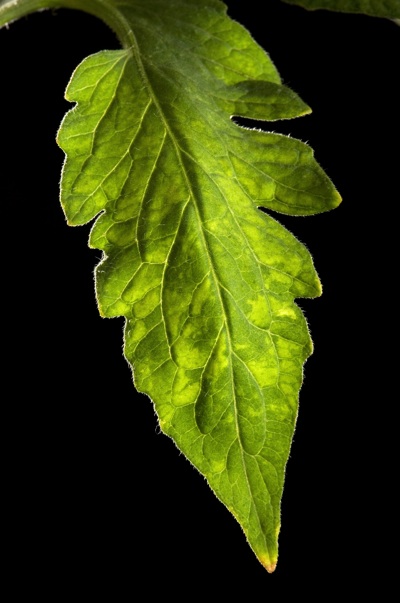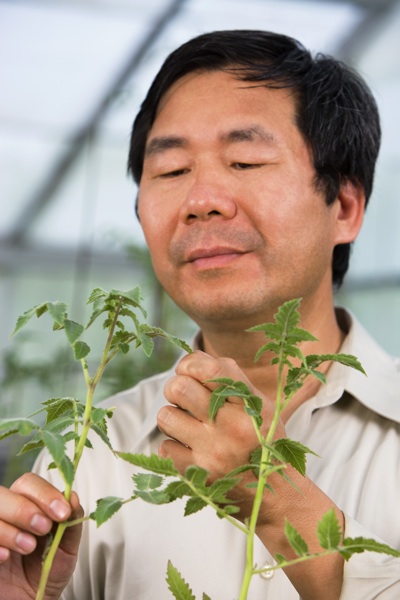
 WEB EXCLUSIVE
WEB EXCLUSIVE
Taming a tomato virus
A tomato that can stand up to attack by a damaging virus in greenhouse
production systems is being developed by an Agricultural Research
Service scientist.

|
|
| Plant pathologist Kai-Shu Ling inspects varieties for resistance to PepMV. Photo courtesy of ARS Advertisement
|
|
 |
|
| Tomato leaflet infected with Pepino mosaic virus. The yellow mosaic discoloration shown on the leaf is the most noticeable symptom of the virus in tomato plants. Photo courtesy of ARS. |
July 20, 2009 – A tomato that can stand up to attack by a damaging virus in greenhouse production systems is being developed by an Agricultural Research Service (ARS) scientist.
ARS plant pathologist Kai-Shu Ling is studying the origins and evolution of Pepino mosaic virus (PepMV), which can damage tomato fruit, stunt growth and leave the plant vulnerable to other infections.
It’s important to find tomatoes that resist the virus in the greenhouse. In 2006, some 652,000 metric tons of greenhouse tomatoes were produced in North America.
Two PepMV strains that infect tomato plants in the United States show a distinct genetic divergence from strains that infect tomato plants in Europe. Ling, who works at the ARS U.S. Vegetable Laboratory in Charleston, South Carolina, studied the genetic makeup of some PepMV strains found in South America, where the virus was first found. He wanted to see if he could tease out the relationships between the PepMV strains found in Europe, South America and the United States.
When Ling examined the makeup of U.S. PepMV strains, he observed a strong similarity to the South American strains. One U.S. strain exhibited almost 99 per cent of the same DNA sequence as a South American strain. Another U.S. strain shared almost 91 per cent of its genetic traits with a different South American strain. However, European strains only shared from 78 per cent to 86 per cent of the genetic characteristics found in South American strains.
Ling also identified three varieties of wild tomatoes with a range of genetic resistance to PepMV. He used the most robust of these varieties to generate new progeny that remained symptom-free after they were exposed to PepMV strains found in South America.
Ling will now use this symptom-free variety to see if he can create a tomato plant with genetic resistance to two U.S. PepMV strains. If he succeeds, he will try to develop a tomato type that has a more general resistance to the European strain of PepMV.
Read more about this research in the September 2008 issue of Agricultural Research magazine, available online at:
USDA Agricultural Research Service
Print this page